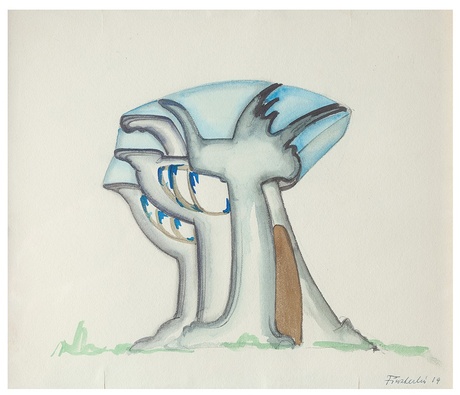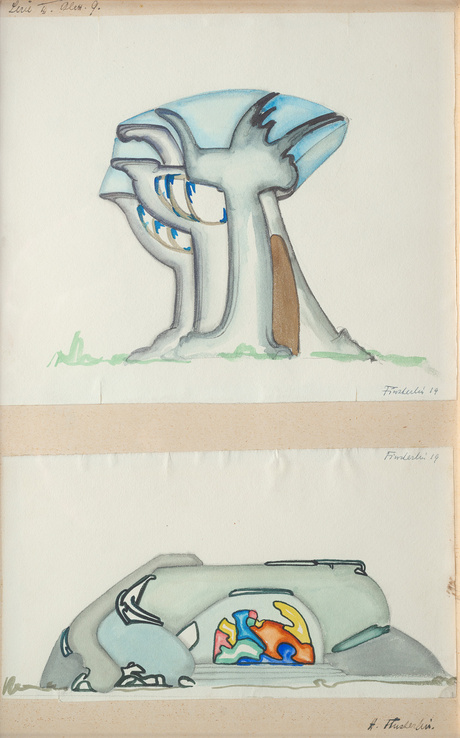Hermann Finsterlin (Munich 1887-1973 Stuttgart)
"Traumhäuser" ["Dream Houses"]
(Visionary Studies of Biomorphic Architecture)
1919
one of two separate watercolors on laid paper, mounted together on cardboard
49 x 31 cm, total dimensions as mounted on cardboard
both signed and dated in pencil "Finsterlin 19"
also inscribed "Serie III. Blatt 9." and signed "H. Finsterlin" in ink on the backing cardboard; and with the artist's estate stamp on the verso
Provenance:
Estate (Nachlass) of the Artist
ex coll. Professor Dr. Karin von Maur, Stuttgart, former deputy director of the Staatsgalerie Stuttgart
Discussion:
Hermann Finsterlin was one of the great visionary or utopian architects of the early 20th century. He was also a painter, poet, essayist, composer, and toy maker.
In 1918 or early 1919, Hermann Finsterlin's "architectural dream" inspired him to design new types of houses. In 1919, when our watercolors were created, Finsterlin was asked by Walter Gropius on behalf of the Arbeitsrat für Kunst [Working Council for Art] to take part in an exhibition of young architects (the "Exhibition for Unknown Architects"). He sent the few "Traumhäuser" ["dream houses"] available, and a telegraphic inquiry about more work led to a veritable frenzy of creativity. His biomorphic architectural visions had little in common with conventional buildings for human use, but rather resembled mythical creatures, deep-sea snails, mussel beds, mushroom colonies, or other exotic-looking organic forms found in nature.
From November 24, 1919, to December 24, 1920, when he resided in Schönau, Finsterlin, under the pseudonym "Prometh," took part in the correspondence of the Glass Chain [Gläsernen Kette], an avant garde community initiated by the German architect and urban planner Bruno Taut, in which mainly architects were involved and the primary medium of intellectual exchange was correspondence and circulars (a chain letter), about utopian ideas.
In 1926, Finsterlin’s family moved to Stuttgart, where their
own house was built by the anthroposophical architect Felix Kayser.
Although Finsterlin's architectural designs were successful in exhibitions at the time and admired, none of his designs were implemented (not unlike Fidus whose drawings of visionary architecture in The Daulton Collection were also never realized as built structures). Finsterlin has therefore been called an architect who "never built a permanent structure." Timothy O. Benson, et al., Expressionist Utopias (Berkeley: University of California Press, 2001), at pg. 201. However, "Da Monsta," an expressionist gate house in Philip Johnson's Glass House compound, is thought to have been inspired by Finsterlin's work.


